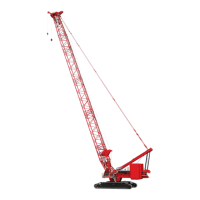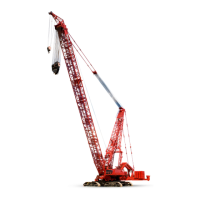ACCESSORIES MLC80A-1/MLC90A-1/MLC100A-1/MLC100-1 SERVICE/MAINTENANCE MANUAL
10-2
Published 10-09-2020, Control # 259-06
GANTRY CYLINDER OPERATION
See Figure 10-1 and Figure 10-2
Gantry Cylinders Overview
The gantry cylinders are controlled by a switch either on the
remote control or on the right side cab console.
The system consists of the main pump A, a 2-position,
proportional solenoid-operated accessory enable control
valve, a 3-position, solenoid-operated control valve, and two
double-acting hydraulic cylinders with holding valves.
The setup remote control communicates with the gantry
cylinder solenoid valves via the CCS.
The switch on the cab console communicates with the gantry
cylinder solenoid valves via the CCS.
To activate the setup remote control, it must be turned in
crane’s main display. See the Main Display Operation
Manual provided with the crane.
To activate the gantry cylinders switch on the cab console,
the Boom Butt Configuration must be selected in the RCL/
RCI Display. See the RCL/RCI Operation Manual supplied
with the crane.
Both gantry cylinder switches are 3-position momentary
switches that are spring returned to the off position when
released.
Neutral
When there is no command from either gantry cylinders
switch, the following occurs:
• The solenoid on the accessory enable valve is
deenergized and a spring shifts the valve to block pump
A flow to the high pressure accessory valve bank.
• The solenoids on the gantry cylinders control valve are
deenergized and springs shift the valve to the neutral
position.
• The gantry cylinders are help in their last position by the
holding valve on each cylinder.
Retract
When a retract command is sent by either gantry cylinders
switch, the following occurs:
• The proportional solenoid on the accessory enable valve
is energized by a PWM (pulse width modulation) signal
from the CCS to adjust the flow rate of oil to the high
pressure accessory valve bank.
• At the same time, the retract solenoid on the gantry
cylinders control valve is energized by 24 V
DC
from the
CCS.
• The energized solenoid shifts the valve spool to the
position that routes hydraulic oil to the rod end of the
gantry cylinders.
• Pressure from the rod ends of the cylinders pilots open
the load holding valves allowing the oil from the barrel
end of the cylinders to flow back to tank via the high
pressure accessory valve.
• The cylinder rods retract to lower the gantry.
Load Holding
If hydraulic pressure is lost for any reason, the holding valves
close and the check valve traps the oil in the barrel end of
each cylinder, preventing the cylinders from retracting.
Extend
When an extend command is sent by either gantry cylinders
switch, the following occurs:
• The proportional solenoid on the accessory enable valve
is energized by a PWM signal from the control system to
adjust the flow rate of oil to the high pressure accessory
valve bank.
• At the same time, the extend solenoid on the gantry
cylinders control valve is energized by 24 V
DC
from the
CCS.
• The energized solenoid shifts the valve spool to the
position that routes hydraulic oil to the barrel end of the
gantry cylinders.
• The oil flows over the load holding check valves to the
barrel end of the cylinders and the cylinders extend to
raise the gantry.
• The hydraulic oil in the rod end of the cylinders flows
back to tank via the high pressure accessory valve.
BOOM HOIST OPERATION
See Figure 10-1 and Figure 10-2
The thumbwheel on the remote control operates the boom
hoist in the same manner as the control handle in the cab.
The boom hoist park switch in the cab must be unparked to
operate the boom hoist.
The sync switch allows the gantry cylinders to follow along
with the gantry when the boom hoist thumbwheel is used to
raise and lower the gantry during counterweight installation
and removal.
